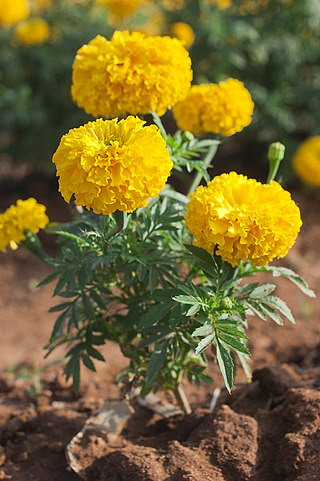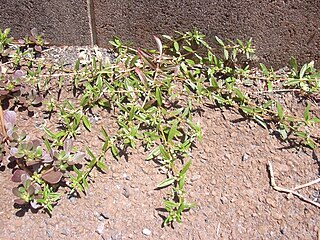
Tagetes is a genus of 50 species of annual or perennial, mostly herbaceous plants in the family Asteraceae. They are among several groups of plants known in English as marigolds. The genus Tagetes was described by Carl Linnaeus in 1753.

The Guam rail, known locally and in Chamorro as ko'ko', is a small, terrestrial bird in the Rallidae family. They are endemic of the island of Guam, and are one of the island's few remaining endemic bird species. The species became extinct in the wild in the early 1980s when biologists captured the remaining wild population. They have since been successfully reintroduced to Guam and introduced to the nearby Rota and Cocos islands. In 2019, the species became the second bird after the California condor to be reclassified by the IUCN from extinct in the wild to critically endangered.

The Guam flying fox, also known as the little Marianas fruit bat, is an extinct species of small megabat endemic to Guam in the Marianas Islands in Micronesia that was confirmed extinct due to hunting or habitat changes. It was first recorded in 1931 and was observed roosting with the larger and much more common Mariana fruit bat. The last specimen was a female found roosting at Tarague cliff in March 1967, but it escaped capture. An unconfirmed sighting took place sometime during the 1970s, and no other individuals have been sighted since then.

Intsia bijuga, commonly known as Borneo teak, Johnstone River teak, Kwila, Moluccan ironwood, Pacific teak, scrub mahogany and vesi, is a species of flowering tree in the family Fabaceae, native to the Indo-Pacific. It ranges from Tanzania and Madagascar east through India and Queensland, Australia, Papua New Guinea to the Pacific islands of Fiji and Samoa. It grows to around 50 metres tall with a highly buttressed trunk. It inhabits mangrove forests. Intsia bijuga differ from Intsia palembanica in the number of leaflets that make up their compound leaves.

Oldenlandiopsis (creeping-bluet) is a genus of flowering plants in the family Rubiaceae. It is monospecific, comprising only one species, Oldenlandiopsis callitrichoides. This species had previously been placed in Hedyotis or in Oldenlandia. It is native to the West Indies, southern Mexico, and Central America. It is naturalized elsewhere, including Florida, Hawaii, South America, and tropical Africa.

Oldenlandia is a genus of flowering plants in the family Rubiaceae. It is pantropical in distribution and has about 240 species. The type species for the genus is Oldenlandia corymbosa.
Droogmansia is a genus of flowering plants in the legume family, Fabaceae. It belongs to the subfamily Faboideae. It includes 22 species which are native to tropical Africa, ranging from Guinea to Tanzania, Mozambique, Zimbabwe, and Angola.

Scleromitrion diffusum, synonyms including Hedyotis diffusa, is a species of flowering plant in the family Rubiaceae. It is a herb used in traditional Chinese medicine, known as Chinese: 白花蛇舌草; pinyin: báihuā shéshécǎo; lit. 'white flower snake-tongue grass', sometimes abbreviated to 蛇舌草 shéshécǎo. It is sometimes combined with Siraitia grosvenorii and Scutellaria barbata to make hot drinks like lohoguo of guongsei or luohanguo pearl and sheshecao beverage.
Hedyotis (starviolet) is a genus of flowering plants in the family Rubiaceae. Many species of this genus such as Hedyotis biflora, H. corymbosa and H. diffusa are well known medicinal plants. Hedyotis is native to tropical and subtropical Asia and to islands of the northwest Pacific. It comprises about 115 species. The type species for the genus is Hedyotis fruticosa.

Kadua is a genus of flowering plants in the family Rubiaceae. It comprises 29 species, all restricted to Polynesia. Twenty-two of these are endemic to the Hawaiian Islands. Some of the species are common at high elevation. Others are single-island endemics or very rare, and a few are probably extinct. Kadua affinis is widely distributed in Hawaii and is polymorphic. The type species for the genus is Kadua acuminata.

Tabernaemontana pandacaqui, known as windmill bush and banana bush, is a species of plant in the dogbane family Apocynaceae.

Spermacoceae is a tribe of flowering plants in the family Rubiaceae and contains about 1346 species in 57 genera. Its representatives are found in the tropics and subtropics.
Plants of the World Online (POWO) is an online database published by the Royal Botanic Gardens, Kew. It was launched in March 2017 with the ultimate aim being "to enable users to access information on all the world's known seed-bearing plants by 2020". This was Kew's answer to the "2020 target 1" of the Convention on Biological Diversity (CBD): "an online flora for all known plants."
Hedyotis indirae is a species of flowering plant in the coffee family Rubiaceae that is endemic to Western Ghats in India. It is a new shrubby species of Rubiaceae from Muthikulam forest of Palakkad district in Kerala.
Droogmansia megalantha is a plant in the legume family Fabaceae, native to southern tropical Africa.
Tridynamia is a genus of flowering plants belonging to the family Convolvulaceae.
Raputia is a genus of flowering plants belonging to the family Rutaceae.

Leptopetalum biflorum, synonym Hedyotis biflora, is a species of flowering plant in the family Rubiaceae.

Hedyotis scabridifolia is an herb or small shrub that is endemic to the volcanic soils of the Mariana Islands of Guam, Rota and Saipan.













